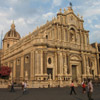The origin of Acireale
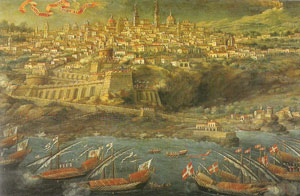 The name of Acireale, once called Aquilia, goes back to ‘600 and originates from a very ancient mythological Greek legend.
The name of Acireale, once called Aquilia, goes back to ‘600 and originates from a very ancient mythological Greek legend.
This legend says that the young shepherd Aci fell in love with the beautiful nymph Galatea. The jalousie of the Cyclops Polypheme, who was also in love with Galatea, led to the killing of the poor young by flatten him under a big stone. The blood of the poor shepherd formed a river called Akis, most of it flows under the ground and comes out of the soil near Santa Maria la Scala and its nickname is “U sangu di Jaci" (Aci’s blood).
The adjective “Royal” has been added in 1642 by a decree of Philip IV of Spain to distinguish Acireale from the other villages of the neighbourhood and to underline his predominance, as a state town, on the other baronial Acis as Aci Trezza, Aci Castello, Aci Catena, Aci Sant’Antonio, Aci Bonaccorsi and so on.
Acireale Today
Nowadays Acireale is known for its famous and coloured Carnival, during which you can admire many carnival floats made of papier-mâché, inspired by the major political events and by the most important current issues, and carnival floats fully covered by flowers, very suggestive and original, a very masterpiece of the local artisans.

Moreover, the feast of Saint Sebastian is very important to Acireale. It’s the first significant event of Acireale’s calendar, which starts in January.
On the 20th January, the most important day of the feast, you can take part to a procession starting from the Basilica in thee morning, leaded by the statue of the Saint, and moves around the town among both historical and modern quarters. Acireale is particularly devoted to the Saint, in fact the population calls him with dialectal diminutive epithets (the most used is “rizzareddu”, “little curly-haired”); the reason of that devotion was having spared the town from the medieval pestilence.
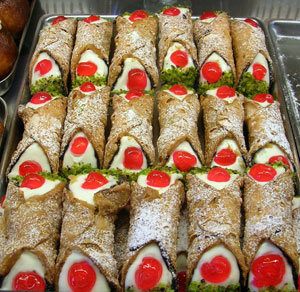
Another peculiarity of Acireale is formed by the thermal baths and its seaside villages, like Capo Mulini. The ones who choose our B&B will have many attractions to visit in this wonderful town of the Catania area. A first place not to miss is the Cathedral Square, where you can see many significant buildings as the Cathedral Church, Saints Peter and Paul Basilica, the Municipal Palace, Modò Palace. Along the whole town you can admire the historical shapes of the Sicilian baroque, like houses, lava portals, big masks carved into the lava, the balconies of the noble buildings.
For those who don’t want to miss the opportunity to taste our Mediterranean cuisine, in particular our deliciousness, you have to try our fresh fish products, the delicious lemon or almond “granita”, almond milk, the various pastries and, least but not last, the traditional ricotta cheese “cannolo” or the sweet, coloured almond paste.
Churches and Palaces of Acireale
There are different interesting places to visit in the town of a hundred bells, starting from the city centre with the Cathedral Square. In this place there are many beautiful and significant buildings: the Cathedral, Saints Peter and Paul Basilica, the Municipal Palace and Modò Palace.
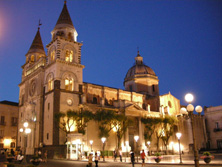
- The Cathedral, date from the XV century and dedicated to Holy Mother, has been restructured several times in the last years and nowadays it’s voted to the worship of the patron saint “Santa Venera”. Inside of the Church you can admire some works of Petro Paolo Vasta, Antonio Filocampo, Giuseppe Sciuti, Francesco Patanè, Vito D'anna e Giacinto Platania.
- Saints Peter and Paul Basilica, built in the baroque style, date from 1550. Its peculiarity is its unique nave. Inside you can admire the statue of Christ of the Column, very venerated in the town, which is brought in procession every 70 years.
- Il Palazzo del Comune, in stile barocco, risalente al 1640 ma ricostruito, a causa di danneggiamenti, negli anni successivi. Molto particolari sono i mascheroni che reggono le mensole dei balconi.
- Modò Palace, whose original structure has been damaged during the years, has been later redecorated in the baroque style and it also has some big lava masks under the balconies. Inside of it, from 1909, there’s the Eldorado Theatre.
Walking along the streets of the city centre there are other buildings, museums, churches and monuments which can attract your attention:
- the Library and Picture Gallery Zelantea;
- the “Colleggiata” of Saint Sebastian Basilica (declared national monument);
- Saint Anthony of Padua Church;
- Santa Maria del Suffragio Church;
- San Camillo Church.
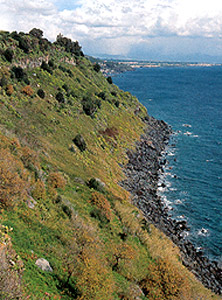
One of the main streets of the centre is Corso Umberto, on which there are many noble buildings. Passing through Corso Umberto you can reach Garibaldi Square and the Maugeri Theatre. Over this square you can get to Indirizzo Square, the municipal park, Villa Belvedere.
The Timpa of Acireale Nature Reserve
The Timpa is a headland 80 m high, above the Acireale coast.
Since 1999 it has been declared nature reserve and is formed by volcanic terraces rocks and faults with a thick vegetation; the area of the reserve has an uncontaminated and preserved territory, even if part of a particular context like the eastern coast in the north side of Catania.
The Timpa nature reserve is composed by a 6 km strip which goes parallel to the coast, close to it, starting from Acque Grandi (near the village of Capo Mulini) until the mountainside village of Santa Maria degli Ammalati.




